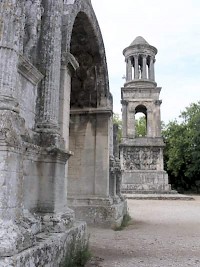Glanum (St.Rémy-de-Provence)
Q674543Glanum: Roman village in southern France, modern St.Rémy-de-Provence.

Glanum is best-known as a Roman town in southern Gaul, in the country of the Salluvii. The first inhabitants, however, had come to live here in the seventh or sixth century BCE. A stone rampart with a length of some 300 meters blocked the road to the Alpilles.
Pottery and coins, thrown as offerings into the a hole above a spring, suggest that this original, Gaulish settlement was religious in nature. A Celtic god, Glan, together with the Glanic Mothers, were believed to live in the waters, which had healing properties. They gave their name to the later, Roman town.
Contacts with the Greek world brought wealth to the town, resulting in the extension of the inhabited zone and the construction of buildings in Greek style in the second century BCE. Glanum benefited from the construction of the Via Domitia, which facilitated travel to Italy and Spain.
During the first years of the reign of the emperor Augustus (r. 31 BCE - 14 CE), the town received the rank of colonia, became a real city and soon was one of the most important centers of Roman civilization west of the Alps. This resulted in the rapid and profound transformation of the city's architecture. The monumental center and a residential area have been excavated.

After a golden age in the second and early third centuries CE, the Germanic invasions put an end to Glanum. The town was abandoned. In the Merovingian period, it had come into possession of the Abbey of Saint-Remi in Reims.
Today, the town boasts two monuments that are together called "Les antiques": the southern gate of Glanum and a tower-shaped mausoleum, which is one of the best-preserved monuments from the ancient world.